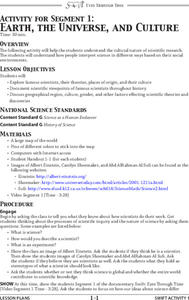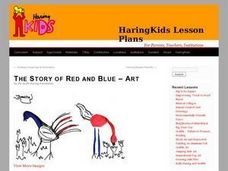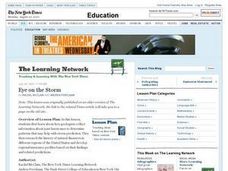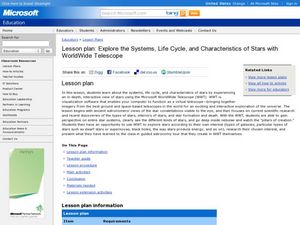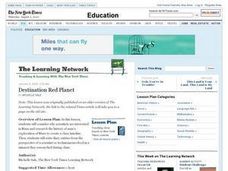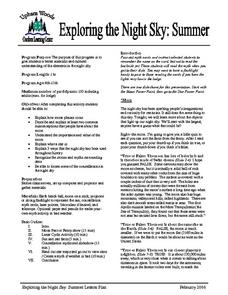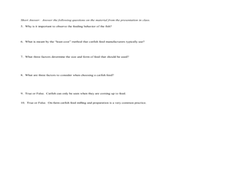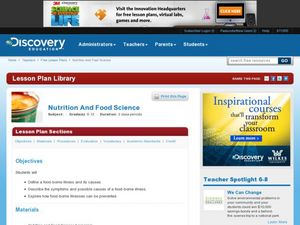Curated OER
From Ada to Grace to Sandy - Women Have IT
Explore the significant contributions women have made in the field of information technology with an instructive lesson plan. Through class discussion and research, learners discover how women have aided in the growth of the field of...
Curated OER
Earth, the Universe, and Culture
Students view segment of documentary, Swift: Eyes Through Time, explore famous scientists, their theories, places of origin, and culture, document scientific viewpoints of famous scientists throughout history, and discuss geographical...
Curated OER
The Story of Red and Blue: Art
Young scholars identify art history by examining a list of images on-line. In this painting instructional activity, students identify the work of Keith Haring by researching the Internet and discuss his style of artwork. Young scholars...
Curated OER
Nature, Red in Tooth and Claw
Young scholars explore the science and art of taxidermy, and research various biomes that could be depicted in museum displays. They synthesize their knowledge by creating dioramas that depict the diverse life forms typical of these biomes.
Curated OER
Eye on the Storm
Young scholars discover the way geologists collect information about past hurricanes to determine patterns that may help with storm prediction. They then research the history of natural disasters in different regions of the United States...
Curated OER
The Forgotten Cities
Students recognize and identify gaps in historical and archaeological evidence and how that evidence is interpreted. They explore the history of the Indus cities and identify what was left behind that survived for archaeologists to find...
Curated OER
INVENTIVE LIVES
Students consider the qualities that inventors possess and explore the history and uncertain future of U.S. innovation by reading and discussing the article "Are U.S. Innovators Losing Their Competitive Edge?"
Curated OER
Explore the Characteristics of Stars with Microsoft WorldWide Telescope
Students explore the characteristics of stars. In this space science activity, students use the Microsoft WorldWide Telescope program to identify the properties of stars and identify the stars in the galaxy.
Curated OER
The Roots of Religion: Teacher’s Guide
Students explore ancient cultures. In this ancient religions lesson, students study the civilizations of ancient Mesopotamia they watch "Garden of Eden" and discuss their impressions. Students then research Sumer and prepare...
Curated OER
Pass the Peace Pipe
Students investigate the history of smoking in the United States. In this history of smoking lesson plan, students read about the Native American influence on early settlers before researching the Internet for information about the...
Curated OER
Flambe Elements
Eighth graders discuss atoms and electrons as well as atoic structure. They view atomic structure via the computer. Students watch a demonstration in which the teacher demonstrates glass tubing turning yellow in a Bunsen Burner flame....
Curated OER
Bang! You're Alive
Young scholars explore the Big Bang Theory and the Theory of Plate Tectonics. In this history of life lesson, students explain two ways the Theory of Plate Tectonics and the Big Bang are of direct benefits to humans.
Curated OER
Destination Red Planet
Students explore reasons why people are interested in exploring other planets. After reading an article, they identify developments in the mission to Mars. Using the internet, they research the history of exploring Mars and create a...
Curated OER
Can't Live With 'Em, Can't Live Without 'Em
Students compare/contrast the factors that create strong relationships between countries, researching the evolving relationship between Britain and France. They create a scrapbook that documents the major events in the history of Britain...
Curated OER
Exploring the Night Sky: Summer
Students explain how moon phases occur. They describe and explain at least two common misconceptions that people have about the moon. Students explain what a star is. They explain 3 ways that the night sky has been used throughout history.
Curated OER
Guidebook
Students create a guidebook page about a plant on the school grounds. In this life and plant science lesson, students identify plants around the school, then research the plant and write a narrative about it. Students publish the book...
Curated OER
The Garbage Patch: Two Earth day Lessons
Students view a seven minute video called Gorilla in the Greenhouse. In this Earth day activity, students review the history of Earth day. Students work in groups to describe the life cycle of a plastic bag. Students understand that...
Curated OER
Make Your Own Compass
Students explore magnetism. In this "magnets" science lesson, students make a compass with common household items and explain the relationship between what a compass does and the earth's magnetic fields.
Curated OER
Mission Discovery
Students examine the changes to the space shuttle Discovery and its history by creating a classroom exhibition about NASA's space shuttle program. They create an informative and attractive invitation about the gallery for outside visitors.
Curated OER
Paper Making
Students work together to make recycled paper. They identify examples of recycled materials and discover what can and cannot be recycled. They explore the history of paper making as well.
Curated OER
Venerable Inventors
Students discuss important historic inventors and read their biographical information. For this world history lesson, students describe Alexander Bell, Thomas Edison, and Guglielmo Marconi using vocabulary terms used in their text....
Curated OER
Aquaculture Science
Students research the different careers in aquaculture. In this aquaculture lesson students complete activities that include a PowerPoint presentation.
Curated OER
Science Italian Style: Eruption!
Young scholars explore ways scientists prepare for a volcanic eruption. They observe films of earthquakes, oil spills, volcanoes and hurricanes. Students perform activities to demonstrate the relationship of viscosity to lava flow. ...
Curated OER
Nutrition and Food Science
Pupils examine the causes and symptoms of food-borne illnesses and ways to prevent them. In this nutrition lesson students work in teams to investigate a type of food-borne illness and present a scenario about it.



